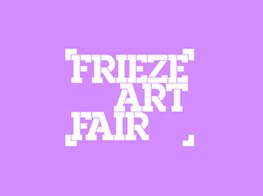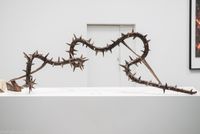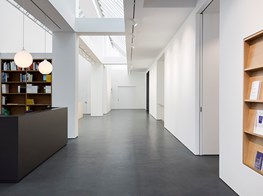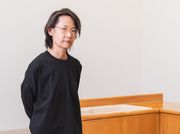Tent Life: Report From Frieze London 2014
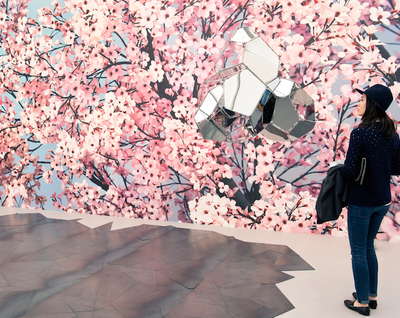
It’s amazing how colourful Frieze London was this year, and it wasn’t just the coloured cards being distributed and fought over at the VIP desk (along with opening invitations) on the shrewdly staggered opening day. (One collector was overheard leaving the fair just after 3pm, because the “hoi polloi” were being let in.)
Indeed, colour abounded. There was Gagosian’s interactive children’s playground by Carsten Höller with walls and floors coloured in modish blocks of yellow, blue, red and green (overlapping in the way Rodrigo Matheus layered coloured acetate panels over envelopes beautifully at Galeria Fortes Vilaça). Next door, wallpaper of a russet forest by the late, great, Angus Fairhurst lit up Sadie Coles HQ, reminiscent of Thomas Demand’s peach blossom wallpaper that brightened up Esther Schipper. Then there was Photoshop Gradient (2014): a carpet divided into red and blue by a sweeping rainbow by Cory Arcangel at Lisson Gallery, which set off works by, amongst others, Arcangel and Ryan Gander, who both provided designed uniforms for gallery staff to wear for the fair’s duration (apparently Gander's trainers manufactured in Japan in association with Adidas, were going for £150 a pop).
All in all, things felt fresh—attributed to the unanimously acknowledged improvement in the contemporary fair’s design over last year’s chaotic, dissonant mess (better lighting, a more organized space): an overall toning down. This was no doubt partially a result of the transferal of Frieze London’s directorship from founders Matthew Slotover and Amanda Sharp to Frieze Masters Director Victoria Siddall (who will also direct Frieze New York). Even still, despite buoyant sales (for some at least) a few galleries continued to grumble (one curator declared Frieze London “zombified”), while others vowed it was time to leave Frieze behind for FIAC.
But dissenters aside, there was a palpable upping of games when it came to how galleries dealt with the fair format, notably via concept booths. Mark Wallinger turned Hauser & Wirth’s space into a version of Sigmund Freud’s study, divided into two halves representing the conscious and unconscious according to wall colour (red and green, respectively). Titled A Study in Red and Green, the booth was a wunderkammer of works, including a sleeping guard and a pair of trainers slung over the booth’s sign by Christoph Büchel. Continuing the domestic trend in the ‘Focus’ section was Leo Xu Projects, presenting a group show titled Model Home. This featured works by video artist Cheng Ran, media artist aaajiao and sound artist/DJ Lou Nanli within a constructed house created by Michael Lin and Atelier Bow-Wow: a domestic space designed with Alexander Rochenko's 1925 "Workers' Club" in mind.
The latter was a welcome insertion of critique in a fair that some felt was light on the challenging side this year, though Goodman Gallery did bring forth Broomberg & Chanarin, and Galleria Raucci/Santamaria, which presented pieces by Tim Rollins + K.O.S and David Jablonowski (including a fantastic, white monochrome assemblage consisting of an HP printer, onyx, aluminum, printing plate, acrylic glass and plaster), inserted a bit of capitalist critique in the form of Danilo Correale’s Cat Bond Band (2013). This consisted of 9 framed chromogenic prints, each depicting the headless portrait of a businessman cut off mid-body by colour blocks within which different phrases were printed, such as: “the worker’s activity is not his own activity. It belongs to another; it is the loss of self,” and “What is the robbing of a bank compared to the founding of a bank?”
Continuing this line of irreverence and incisiveness was Goshka Macuga showing at Kate MacGarry, who presented video documentation and a series of scripts for Preparatory Notes for a Chicago Comedy (2014): a performance recently presented at the 8th Berlin Biennale. Inspired by Aby Warburg's 1896 Hamburg Conversations on Art: Hamburg Comedy), it explores the schizophrenic struggle between traditionalists and the avant-garde by performing a number of imagined conversations amongst figures like Marina Abramovic, John Cage, Andrea Fraser, Angela Merkel, and Dasha Zhukova.
This leads us back to the treatment of booths as domestic spaces, which continued over at Frieze Masters, where Nahmad Contemporary created a fictional Parisian collector’s apartment from 1968, complete with a Fontana hanging over a cluttered desk. It was a popular presentation: a booth that pretty much explained why wallpaper—or in other words, home décor—was in fashion. As Matthew Slotover explained when discussing the decision to close the fair on Sunday so as to limit public access: aside from professionals, this fair is for collectors. (Summed up by Kiluanji Kia Henda’s Instructions on how to create your own personal Dubai at home, 2013 at Galeria Elba Benitez, not to mention Shanzai Biennial's use of their fair space—courtesy of Project Native Informant—to help sell a luxury St. John's Wood abode for a cool £32,000,000, of which they said they would take a healthy commission.)
In this, Nahmad’s booth—the representation of a personal interior and the setting of historical works within that—somehow recalled three pieces back at contemporary relating to other kinds of internal dynamics. Lee Kit’s intimate albeit anxious collection of works at Vitamin Creative Space (which sold out completely) included a video showing a twitching hand; Pablo Bronstein’s watercolour and ink on paper, Prison Block at Herald St was a panopticon within the art fair panopticon; and Gregor Schneider’s eerie depiction of an empty, menacing nursery contained in a shipping crate (Nursery, Walden Street NO.14, London, 2014) at Konrad Fischer highlighted the sense of unease caused by emptiness.
Maybe this is why Wallinger chose Freud as his reference this year, while Sadie Coles HQ also included a bronze statue of a gorilla by Angus Fairhurst gazing into a circular mirror—a nod to the tale of Narcissus. There was a certain level of introspection and self-reflection at Frieze contemporary, which may explain a palpable move from bad painting towards contemplative, considered—(and non-intrusive?)—abstraction. Examples included Mark Hagen’s otherworldly installation at Almine Rech, in which black acrylic on burlap paintings set off minimal, geometric sculptures coloured in fluorescent tones and Alma Allen’s scholar’s rock-esque yule marble sculpture Not Yet Titled (2014) positioned at Blum & Poe in front of Julian Hoeber’s wonderful painting Double Window (2014). The latter consisted of two narrow columns of blue sky framed on a canvas by gradiated white borders moving outwards towards the picture’s edge—an elemental homage that recalled the ever-wonderful Hajra Waheed’s collection of sea-scapes, Our Naufrage, 2014, at Experimenter (part of focus), and Ignasi Aballi’s Inventario (mares-Mediterráneo) & Inventarios (mares), 2014 at Elba Benitez.
Also striking were Edith Dekyndt’s wonderful Cold Drawings and Blankets at Galerie Karin Guenther (also showing at the ever-excellent Carl Freedman Gallery), shown alongside Berta Fischer’s equally intriguing abstract pieces that employ synthetic materials including PVC and acrylic glass. Svenja Deininger also impressed with her geometric abstractions at Marianne Boesky, who also showed Diana Al-Hadid’s ghostly cast sculptures. These included Outdoor Lady: the seemingly melting form of a woman perched on a pedestal (ala Edvard Eriksen’s little mermaid).
The body was a big theme, too. Marlborough dedicated their whole booth to Francis Bacon at Masters, and Freedman Fitzpatrick gave over theirs to figurative paintings by Matthew Lutz-Kinoy at Focus. Other works included a crowd-pleasing giant bronze sausage man by Erwin Wurm at Thaddaeus Ropac, and Matthew Darbyshire’s multi-coloured update of a classic Greek figurative sculpture at Herald St: Polykleitos’s Doryphoros, CAPTHCA No.15 - Doryphoros (2014). Going another route was Hans Peter-Feldman’s Bookshelves—three photographs of a bookshelf, with one publication spine prominently reading, THE BODY, at 303 Gallery. The emphasis made sense: this year was the launch of Frieze’s “Live” section for performance art (in lieu of “Frame”), featuring six artists and projects: Robert Breer (gb agency); Franz Erhard Walther (Galerie Jocelyn Wolff); Tamara Henderson (Rodeo); Adam Linder (Silberkuppe); Shanzhai Biennial (Project Native Informant); UNITED BROTHERS (Green Tea Gallery). Riffing off this new development, Michael Werner Gallery presented an effective restaging of James Lee Byars’s 10 in a Hat performance, in which ten performers connected by a long pink sash complete with interconnected hats caterpillared through the fair’s corridors.
The Live section provided most of Frieze’s bite, despite some questioning whether presenting performance in the fair context worked. Adam Linder’s performance at Silberkuppe, Some Proximity, rebuffed such criticisms by seamlessly working with the fair context without being over taken by it. This was achieved by turning a stark, white booth into a stage within which either Linder or his partner—taking turns—snaked around, contorting their bodies to a repetitive, rhythmic soundtrack while the other recited words scribbled onto paper in the manner of beat poetry. These were reflections on the fair, including praise for fellow “Live” performance, Tamara Henderson’s “enforced relaxation booth” (“a feast of sass”), and insights into fair behavior (as when a gallerist demanded, during Kim Gordon’s contribution to Nick Mauss’s Frieze Project performance, “an end to all noise” because she’d paid $400,000 for her booth).
Linder’s observations on art world behaviour—like an anthropologist studying a tribe (much like Eric Fischl painting scenes from art fairs, showing at Victoria Miro)—reflected another trend this year that was summed up by the title of a panel given as part of Frieze Talks—Adventures in the Field: The Anthropological Turn. This was exemplified not only through visual references to archeologies, taxonomies and enthnographies, but through material approaches, as shown in Ancient & Modern’s entire booth, not to mention at Sultana, which presented yarn and acrylic canvas paintings by Jacin Giordano (which echoed Seung-Taek Lee’s canvas frames wrapped in yarn at MOTInternational), and tribal masks and pebble necklaces produced by Olivier Millagou. In a solo presentation at Anton Kern, Mark Grotjahn presented iterations of Tabwa masks amongst other works, while Stevenson showed a remarkable bust by Wim Botha fashioned from volumes of the Encyclopedia Britannica, Untitled (bywoner 8) (2014), while Tanya Bonakdar showed Haim Steinbach’s Untitled (Jamaican head Mobius Strip) (2014) alongside a wooden assemblage by Mark Manders, Short Scene on Wooden Floor (2014), who was also showing Landscape with Fake Dictionary (2014) painted wood at ZENO X.
This material and cultural remix was also reflected in Masters, where everything from Cycladic antiquities to works produced just before 2000 were mashed up in a number of ways, from Spotlight’s archaeology into various art histories, including a wonderful presentation of paintings by Dia Azzawi at Meem Gallery and Huguette Caland at Agial Art Gallery, delicate, ritualistic sculptures by Salvador Mestre Did at Paulo Darzé Galeria de Arte, and brightly-coloured collages by Romaire Bearden at DC Moore. One stand out booth at Masters (aside from Blum & Poe and Kukje’s excellent presentation of Tansaekhwa) was Pace, which positioned works by Mondrian, Beuys, Rauschenberg, Calder, Schwitters, Albers, Leger, Gonzalez, de Kooning, Matta, and Samaras, against a collection of tribal objects from places including the Congo, Nigeria, and the Ivory Coast. Of course, over at contemporary, Jeremy Deller at The Modern Institute was on hand to make sense of why such mixings might have taken place, with a screenprint of a smiley face presented alongside Neolithic implements titled Justified and Ancient (2014).
In the end, the cumulative effect of both Frieze fairs this year, having visibly unified in terms of design and aesthetic experience, was summed up in Anne Collier’s 2011 works, Questions (Relevance) and Questions (Supposition) presented at Corvi-Mora, the former asking such queries as, “What does it all mean?” Especially when thinking about how this fair, despite its best efforts, always manages to feel just that little bit “off”. Adam Linder’s performance provided an answer: “A tent, however expansive, is still a tent. And in this tent a calcified production line might pop out paintings, but the real work is expressed in the body.”
It’s true. As one visiting director commented, Frieze is a bubble in more ways than one. Naturally, this affects our experience of it, as we wander through its dense corridors as witnesses rather than active participants. After all, like one reporter observed: to not think about the market at a fair would be missing the point. Quoting Linder again, this “makes strange pedestrians of all of us.”—[O]

